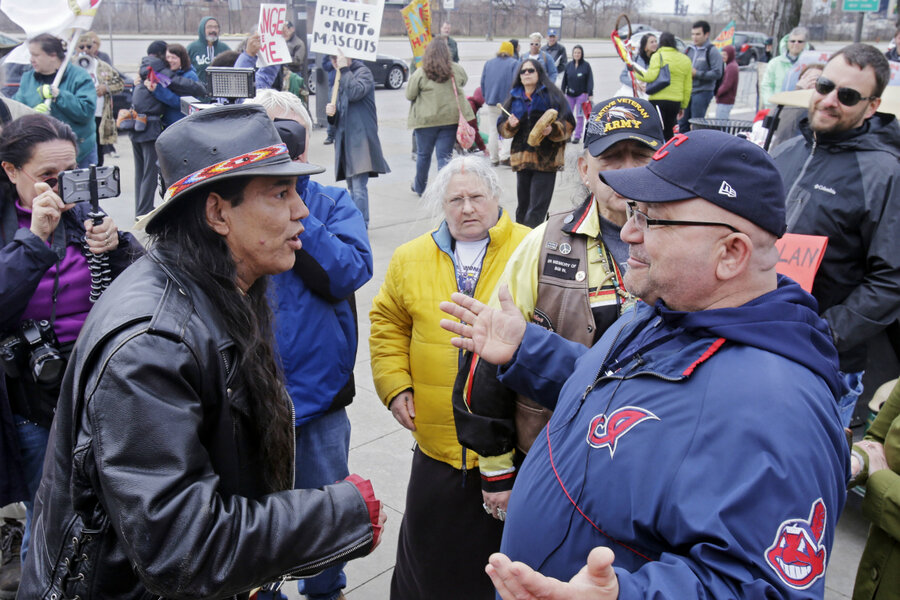'Chief Wahoo' out: the mascot debate
Loading...
The announcement in January that the Cleveland Indians will remove the “Chief Wahoo” logo from use on the field has invited a reexamination of sports teams’ use of Native American-inspired names and imagery. Research presents arguments against the use of Native American sports mascots, so why does the practice persist?
Q: What was behind the decision to remove Chief Wahoo?
The Cleveland Indians will not use the “Chief Wahoo” logo – a grinning, red-faced, and feathered caricature of a Native American used since the 1940s – on the field beginning with the 2019 season.
The Major League Baseball team, however, will still sell merchandise with the logo in the Cleveland area. It would lose its trademark if it discontinued all use of the image.
The team has been phasing out Chief Wahoo since 2009, replacing the logo on most jerseys and caps with a “C” and in 2014 removing all Chief Wahoo signs inside its ballpark. Native American groups have long been vocally opposed to the caricature, saying it is racist, and have staged protests before home openers.
In the announcement about Chief Wahoo, the team and the league said the removal does not mean the franchise’s name will change.
Q: How many sports teams have names referring to Native Americans?
On the professional level, five teams have names that refer to Native Americans: in the National Football League, the Kansas City Chiefs and Washington Redskins; in baseball, the Atlanta Braves and Cleveland Indians; and in the National Hockey League, the Chicago Blackhawks.
In 2005, the National Collegiate Athletic Association banned Native American mascots. Eighteen schools were told to drop their mascots, but eight, after getting support from local Native American tribes, appealed the decision and retained their names and logos.
A recent search of MascotDB.com, a database of mascots in the United States, indicated that 2,286 high schools in the country still have Native American names or mascots.
Q: Why did teams start using these names and logos?
Sports logos are just one kind of reference – in a grouping that also includes the packaging for Land O’Lakes butter and the Apache helicopter – that connect to Native Americans, said Paul Chaat Smith, a curator at the Smithsonian’s National Museum of the American Indian, in an interview with The Atlantic. Mr. Smith’s most recent exhibit at the museum, “Americans,” explores Native American imagery.
The use of Native names and imagery in sports has its roots in the 1876 Battle of the Little Bighorn, when the Lakota Sioux and Northern Cheyenne defeated the US Army. After that battle, Native Americans “became associated with being [a] fiercely intelligent and confident fighting force,” Smith said, according to Smithsonian magazine.
Q: What are the arguments for continuing to use these names and mascots?
Some teams say their names honor Native Americans generally, or sometimes even specific individuals affiliated with the teams. For example, the Cleveland Indians say their name honors Louis Sockalexis, the first Native American – as well as the first recognized minority – to play in the National League when he was signed by the then-Cleveland Spiders in 1897.
In 1915, the team’s then-owner Charles Somers asked sportswriters from four Cleveland newspapers to come up with a new name for the team. They suggested the Indians. Before then, the team had been known as: the Infants, the Spiders, the Bronchos, the Blues, the Naps and unofficially called the Exiles, the Castoffs, the Misfits, the Molly McGuires, and other names. In news coverage the day of the announcement, there was no mention of Mr. Sockalexis. However, newspapers originally used the nickname because of the excitement surrounding Sockalexis joining the team as the league’s first Native American baseball player.
The attachment to various symbols also has to do with the fact that sports fandom, in general, provides people with a sense of belonging, distinctiveness, and meaning, says Daniel Wann, who studies the social psychology of fans at Murray State University in Kentucky.
For people whose fandom is a key part of their identity, mascots are so connected to the team that the team and mascot “become one and the same,” says Professor Wann, which means a mascot change can be upsetting even in the cases when fans perceive the mascot to be racist.
Team logos, however, have changed for many other reasons and fans, while initially upset, “do adapt and get over it,” says Wann.
Q: And the arguments against?
Pauline Turner Strong, an anthropology professor at the University of Texas at Austin, says that “playing Indian” – that is, instances in which other members of society take on imagined Native characteristics – has been a phenomenon since the colonization of the US. “Belonging through reference with ‘pseudo-Indian’ symbols ... is earned at the expense of the nonbelonging of Native people themselves,” she says.
These mascots and logos associate Native Americans with animals and nature – most other sports logos refer to animals – and therefore implies Native Americans are inferior to other people, adds Professor Strong. Of the 32 NFL names, over half feature animals. For the MLB, a quarter of the 28 teams derive their names from animals.
Furthermore, these mascots present a problem because there are relatively few other images of Native Americans in mainstream media, writes Stephanie Fryberg, a psychology professor at the University of Washington in Seattle, Wash., in a journal article.
Professor Fryberg’s and other research shows that Native American mascots negatively affect Native youths’ self-esteem, feelings about their community’s worth, and sense of future achievement possibilities. This led the American Psychological Association to call for an end to the practice in 2004.
Q: What else is happening along these lines?
In 2014, the US Patent and Trademark Office canceled six trademarks for the Washington Redskins, saying the name cannot be trademarked because federal law does not protect trademarks with offensive and disparaging language. However, the US Supreme Court ruled in another case in June that the federal government’s ban on offensive trademark registrations violated the First Amendment, effectively ending the legal controversy over the team’s name.
It remains to be seen how each team will respond to the continuing debate. In Cleveland, for instance, the removal of Chief Wahoo comes ahead of the team hosting the All-Star Game in 2019. However, Redskins owner Dan Snyder has said, “We’ll never change the name. It’s that simple. NEVER – you can use caps.”
At the high school level, however, the number of teams using the Redskins name has almost halved from 93 in 1990 to 49 in 2017.
Editor's note: This file has been updated to include additional information and a graphic to illustrate the number of high school sports teams that use Native American imagery.







